人教版(2019)必修三unit2 Morals and Virtues Discovering Useful Structures课件(共21张PPT)
文档属性
| 名称 | 人教版(2019)必修三unit2 Morals and Virtues Discovering Useful Structures课件(共21张PPT) | 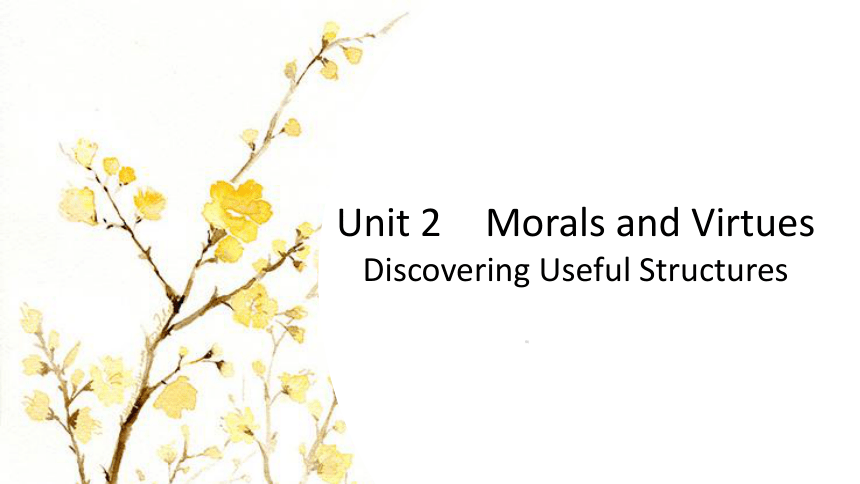 | |
| 格式 | pptx | ||
| 文件大小 | 1.7MB | ||
| 资源类型 | 教案 | ||
| 版本资源 | 人教版(2019) | ||
| 科目 | 英语 | ||
| 更新时间 | 2023-06-08 17:41:15 | ||
图片预览



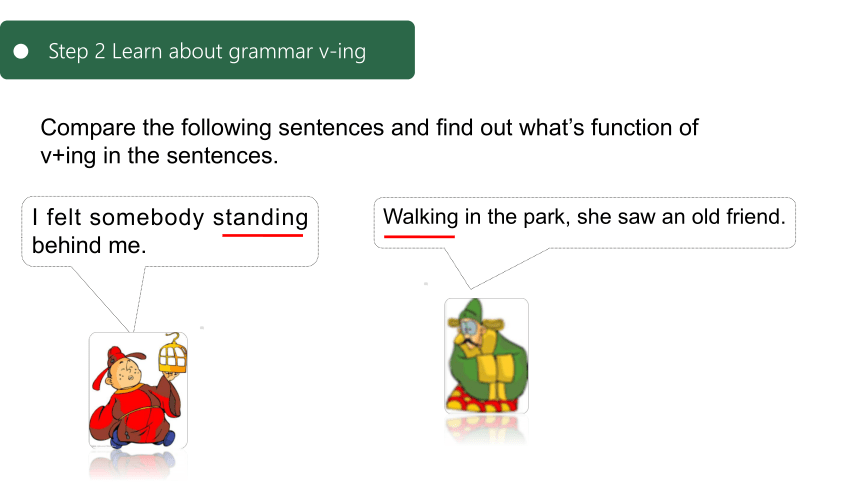
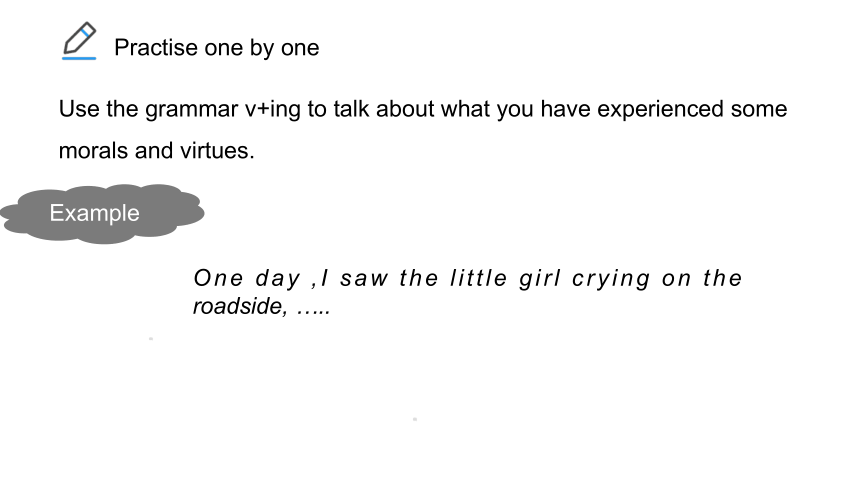
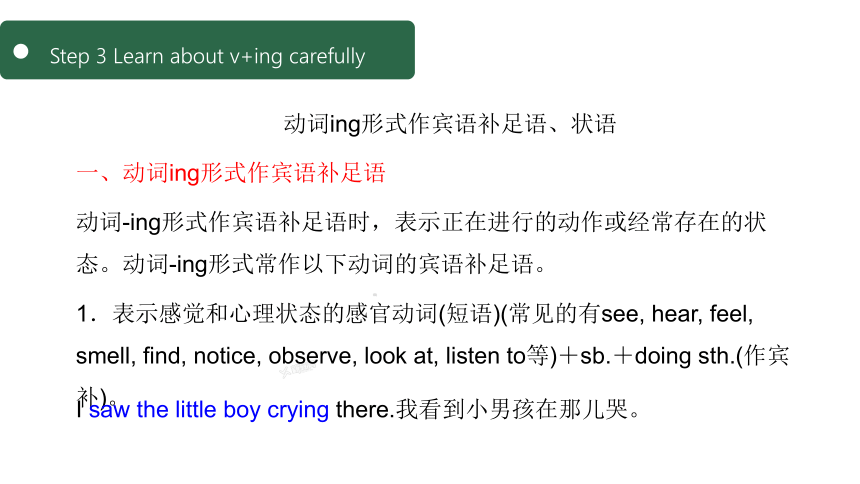
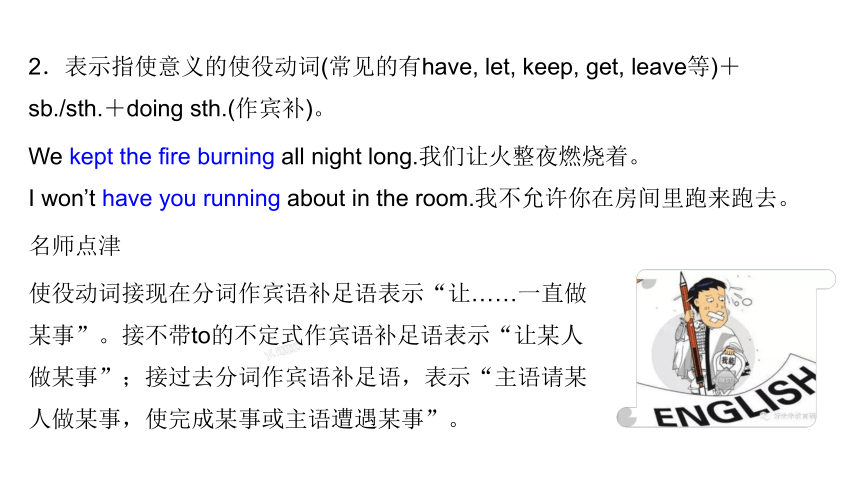
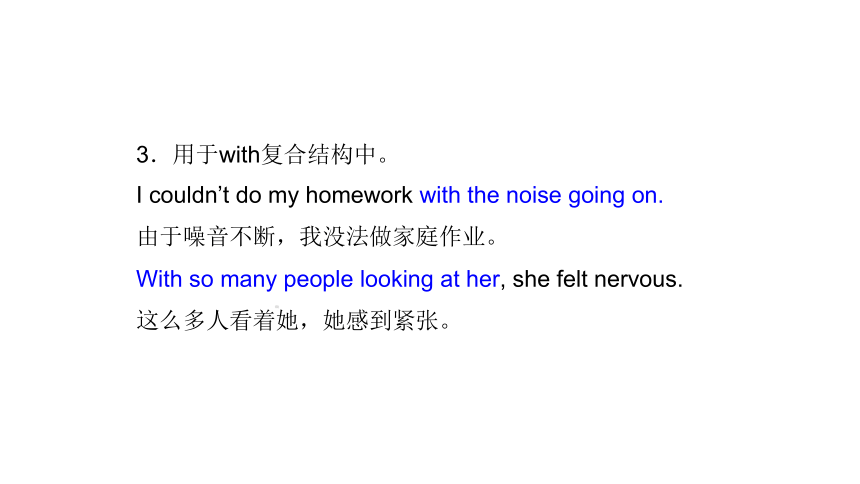
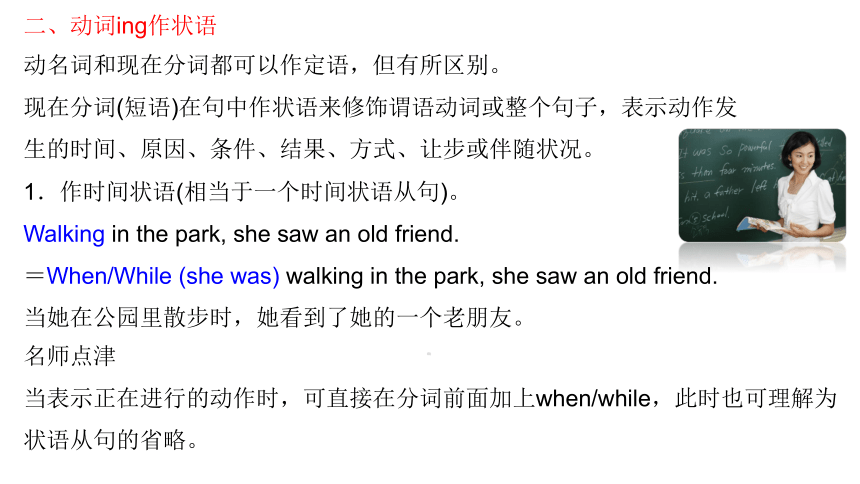
文档简介
(共21张PPT)
Unit 2 Morals and Virtues
Discovering Useful Structures
Talk about some virtues you have done one by one.
Giving
Friendship
Helping
Step 1 Lead-in
Kindness
Hope
Walking in the park, she saw an old friend.
I felt somebody standing behind me.
Compare the following sentences and find out what’s function of v+ing in the sentences.
Step 2 Learn about grammar v-ing
Practise one by one
Use the grammar v+ing to talk about what you have experienced some morals and virtues.
Example
One day ,I saw the little girl crying on the roadside, …..
动词ing形式作宾语补足语、状语
一、动词ing形式作宾语补足语
1.表示感觉和心理状态的感官动词(短语)(常见的有see, hear, feel, smell, find, notice, observe, look at, listen to等)+sb.+doing sth.(作宾补)。
动词 ing形式作宾语补足语时,表示正在进行的动作或经常存在的状态。动词 ing形式常作以下动词的宾语补足语。
I saw the little boy crying there.我看到小男孩在那儿哭。
Step 3 Learn about v+ing carefully
使役动词接现在分词作宾语补足语表示“让……一直做某事”。接不带to的不定式作宾语补足语表示“让某人做某事”;接过去分词作宾语补足语,表示“主语请某人做某事,使完成某事或主语遭遇某事”。
名师点津
2.表示指使意义的使役动词(常见的有have, let, keep, get, leave等)+sb./sth.+doing sth.(作宾补)。
We kept the fire burning all night long.我们让火整夜燃烧着。
I won’t have you running about in the room.我不允许你在房间里跑来跑去。
3.用于with复合结构中。
I couldn’t do my homework with the noise going on.
由于噪音不断,我没法做家庭作业。
With so many people looking at her, she felt nervous.
这么多人看着她,她感到紧张。
二、动词ing作状语
动名词和现在分词都可以作定语,但有所区别。
名师点津
当表示正在进行的动作时,可直接在分词前面加上when/while,此时也可理解为状语从句的省略。
现在分词(短语)在句中作状语来修饰谓语动词或整个句子,表示动作发生的时间、原因、条件、结果、方式、让步或伴随状况。
1.作时间状语(相当于一个时间状语从句)。
Walking in the park, she saw an old friend.
=When/While (she was) walking in the park, she saw an old friend.
当她在公园里散步时,她看到了她的一个老朋友。
2.作原因状语(一般可转换成由as或because引导的原因状语从句)
Being ill, he couldn’t go to school.
=As he was ill, he couldn’t go to school.
因为生病了,他无法去上学。
You should adapt to the changing situation.
你应该适应不断变化的形势。
The ground is covered with fallen leaves.地上满是落叶。
I’m looking for a room to live in.我正在找房子住。
3.作条件状语(一般放在句首,其前可以加if, unless等连词)
Working hard, you’ll make great progress.
=If you work hard, you’ll make great progress.
如果你努力工作,你将取得很大进步。
4.作结果状语
现在分词作结果状语时,通常放在句末,中间用逗号隔开,表示一种顺其自然、意料之中的结果。
The plate dropped from her hands, breaking into pieces.
盘子从她手中掉了下来,摔成了碎片。
名师点津
现在分词作结果状语,是随着谓语动词的发生而产生的自然结果,其逻辑主语往往是前面整个句子所描述的情况,前面有时候可以加thus。而不定式作结果状语时常表示出乎意料的结果,有时前面可以加only。
试比较:
He was caught in the rain, thus making himself catch cold.
被雨淋后他感冒了。
I hurried to school, only to find it was Sunday.
我匆忙赶到学校,结果发现是星期天。
5.作让步、方式和伴随状语
现在分词作让步、方式和伴随状语时,说明动作发生的背景和情况。作伴随状语时,表示分词的动作和主句的动作同时发生,此时它可转换成并列句。
Mary sat by the window of the classroom, reading a book.
=Mary sat by the window of the classroom and was reading a book.
玛丽坐在教室的窗边读一本书。
名师点津
为强调动词 ing形式表达的意义,可在其前加上各种连词。例如,加上when, while,强调与谓语动词同时发生;加上before, after,强调动作先后发生;加上thus,强调结果;加上(al)though,强调让步等。
Though knowing all this, they made me pay for the damage.
尽管他们了解这一切,但还是让我赔偿损失。
三、现在分词作状语注意事项
1.现在分词的时态
现在分词作状语时,要注意分词的时间性,是用现在分词的一般式(doing),还是用完成式(having done)。
(1)当现在分词的动作与谓语动词的动作同时发生时,用分词的一般式。
Walking in the street, I met an old friend of mine.
我正在大街上行走时,遇到了一位老朋友。(walking和谓语动词met同时发生)
(2)当现在分词的动作先发生,而谓语动词的动作后发生时,用分词的完成式。
Having finished the letter, he went to post it.
他写完信后就把它寄了出去。(having finished是先发生的,went是后发生的)
2.现在分词的语态
使用现在分词的主动式还是被动式,这主要取决于现在分词和句子主语之间的关系。句子的主语就是分词的逻辑主语。
Having been shown around the factory, they were very happy.(现在分词的被动式)
被领着参观了工厂后,他们很高兴。
Having finished his homework, he went to bed.(现在分词的主动式)
完成了作业后,他上床睡觉。
3.动词 ing形式的否定式:not+v. ing; not having+v. ed
Not knowing this, he didn’t come.
他不知道这件事,所以没来。
Not having made full preparations,we put off the sports meeting.
因为没有做好充分的准备,我们把运动会延期了。
Step 4 Complete the passage with the underline sentences that using v+ ing form
1. How do you use the function of -ing
2. What’s the difference between -ing
Summary
Homework
1. Go over what we have learned about grammar rules.
2. Finish the exercises about the P18.
Thanks
Unit 2 Morals and Virtues
Discovering Useful Structures
Talk about some virtues you have done one by one.
Giving
Friendship
Helping
Step 1 Lead-in
Kindness
Hope
Walking in the park, she saw an old friend.
I felt somebody standing behind me.
Compare the following sentences and find out what’s function of v+ing in the sentences.
Step 2 Learn about grammar v-ing
Practise one by one
Use the grammar v+ing to talk about what you have experienced some morals and virtues.
Example
One day ,I saw the little girl crying on the roadside, …..
动词ing形式作宾语补足语、状语
一、动词ing形式作宾语补足语
1.表示感觉和心理状态的感官动词(短语)(常见的有see, hear, feel, smell, find, notice, observe, look at, listen to等)+sb.+doing sth.(作宾补)。
动词 ing形式作宾语补足语时,表示正在进行的动作或经常存在的状态。动词 ing形式常作以下动词的宾语补足语。
I saw the little boy crying there.我看到小男孩在那儿哭。
Step 3 Learn about v+ing carefully
使役动词接现在分词作宾语补足语表示“让……一直做某事”。接不带to的不定式作宾语补足语表示“让某人做某事”;接过去分词作宾语补足语,表示“主语请某人做某事,使完成某事或主语遭遇某事”。
名师点津
2.表示指使意义的使役动词(常见的有have, let, keep, get, leave等)+sb./sth.+doing sth.(作宾补)。
We kept the fire burning all night long.我们让火整夜燃烧着。
I won’t have you running about in the room.我不允许你在房间里跑来跑去。
3.用于with复合结构中。
I couldn’t do my homework with the noise going on.
由于噪音不断,我没法做家庭作业。
With so many people looking at her, she felt nervous.
这么多人看着她,她感到紧张。
二、动词ing作状语
动名词和现在分词都可以作定语,但有所区别。
名师点津
当表示正在进行的动作时,可直接在分词前面加上when/while,此时也可理解为状语从句的省略。
现在分词(短语)在句中作状语来修饰谓语动词或整个句子,表示动作发生的时间、原因、条件、结果、方式、让步或伴随状况。
1.作时间状语(相当于一个时间状语从句)。
Walking in the park, she saw an old friend.
=When/While (she was) walking in the park, she saw an old friend.
当她在公园里散步时,她看到了她的一个老朋友。
2.作原因状语(一般可转换成由as或because引导的原因状语从句)
Being ill, he couldn’t go to school.
=As he was ill, he couldn’t go to school.
因为生病了,他无法去上学。
You should adapt to the changing situation.
你应该适应不断变化的形势。
The ground is covered with fallen leaves.地上满是落叶。
I’m looking for a room to live in.我正在找房子住。
3.作条件状语(一般放在句首,其前可以加if, unless等连词)
Working hard, you’ll make great progress.
=If you work hard, you’ll make great progress.
如果你努力工作,你将取得很大进步。
4.作结果状语
现在分词作结果状语时,通常放在句末,中间用逗号隔开,表示一种顺其自然、意料之中的结果。
The plate dropped from her hands, breaking into pieces.
盘子从她手中掉了下来,摔成了碎片。
名师点津
现在分词作结果状语,是随着谓语动词的发生而产生的自然结果,其逻辑主语往往是前面整个句子所描述的情况,前面有时候可以加thus。而不定式作结果状语时常表示出乎意料的结果,有时前面可以加only。
试比较:
He was caught in the rain, thus making himself catch cold.
被雨淋后他感冒了。
I hurried to school, only to find it was Sunday.
我匆忙赶到学校,结果发现是星期天。
5.作让步、方式和伴随状语
现在分词作让步、方式和伴随状语时,说明动作发生的背景和情况。作伴随状语时,表示分词的动作和主句的动作同时发生,此时它可转换成并列句。
Mary sat by the window of the classroom, reading a book.
=Mary sat by the window of the classroom and was reading a book.
玛丽坐在教室的窗边读一本书。
名师点津
为强调动词 ing形式表达的意义,可在其前加上各种连词。例如,加上when, while,强调与谓语动词同时发生;加上before, after,强调动作先后发生;加上thus,强调结果;加上(al)though,强调让步等。
Though knowing all this, they made me pay for the damage.
尽管他们了解这一切,但还是让我赔偿损失。
三、现在分词作状语注意事项
1.现在分词的时态
现在分词作状语时,要注意分词的时间性,是用现在分词的一般式(doing),还是用完成式(having done)。
(1)当现在分词的动作与谓语动词的动作同时发生时,用分词的一般式。
Walking in the street, I met an old friend of mine.
我正在大街上行走时,遇到了一位老朋友。(walking和谓语动词met同时发生)
(2)当现在分词的动作先发生,而谓语动词的动作后发生时,用分词的完成式。
Having finished the letter, he went to post it.
他写完信后就把它寄了出去。(having finished是先发生的,went是后发生的)
2.现在分词的语态
使用现在分词的主动式还是被动式,这主要取决于现在分词和句子主语之间的关系。句子的主语就是分词的逻辑主语。
Having been shown around the factory, they were very happy.(现在分词的被动式)
被领着参观了工厂后,他们很高兴。
Having finished his homework, he went to bed.(现在分词的主动式)
完成了作业后,他上床睡觉。
3.动词 ing形式的否定式:not+v. ing; not having+v. ed
Not knowing this, he didn’t come.
他不知道这件事,所以没来。
Not having made full preparations,we put off the sports meeting.
因为没有做好充分的准备,我们把运动会延期了。
Step 4 Complete the passage with the underline sentences that using v+ ing form
1. How do you use the function of -ing
2. What’s the difference between -ing
Summary
Homework
1. Go over what we have learned about grammar rules.
2. Finish the exercises about the P18.
Thanks
